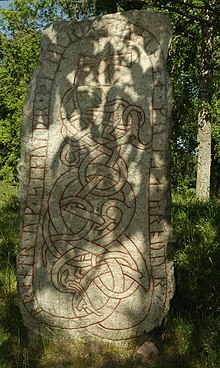Runestones at the church of Lena
The rune stones at Lena Church are located south of Lena near Vattholma in Uppland in Sweden .
Rune stone U 1026
The rune stone U 1026 is located about 150 meters south of the church on the edge of the hill on which the church stands. Next to it is U 1027.
At the beginning of the 17th century, the stone was discovered on the inside of the northern cemetery wall. It was taken out of the wall and erected in 1864 by Richard Dybeck (1811–1877) together with U 1027 and U 1028 at its current location. However, U 1028 later came to the church's Karnhaus . In 1951 the overturned stone was raised again.
The gray granite stone is 1.6 meters high and 0.7 meters wide. The surface is flat and smooth. The Pr 4 runestone incisions are deep and clear, with broad rounded lines.
The text reads: "brantr 'uk' sihuiþr 'litu' risa 'stin' at 'munta' broþur"
Translated: "Brandr and Sigvidr had the stone built for Munda, their brother".
Runestone U 1027
The rune stone U 1027 is located about 150 meters south of the church on the edge of the hill on which the church stands. Next to it is U 1026.
The stone consists of a fragment that formed roughly the left half of the original stone. A smaller fragment that forms the upper part of the right side of the stone is connected to the left fragment. Next to the pieces that have been joined are two smaller fragments that do not fit the others but fit together.
The stone is made of blue-gray granite. It is 1.16 meters high and its greatest width, including the upper fragment, is 0.72 meters. The incisions in the runestone style Pr 4 are deep and clear.
In his travel story from 1864, Richard Dybeck described how the previously unknown stone was found during repairs under the floor in Lena Church. He found that the stone had been smashed by the workers and only a larger and a few smaller fragments remained. The stone was moved to its current position together with the fragments of U 1028 and the rune stone U 1026.
The text received reads: "... [(n) '] uk' ihul 'uk' gisl 'uitr' li ..."
Translated: "... and Igul and Gisl and Önd (?) Let ..."
New find for U 1027
When the floor was re-laid in the nave in 2018, Anna Ölund came across a granite fragment under the old wooden floor . It contained a part in a loop and the three runes "... tu ∙ a ..." When it was pressed against the rune stone U 1027, it turned out to be a perfect match and the sentence "... and Igel and Gisl and Önd läto ..." “Completed. The continuation a ... means that the usual phrase "resa stenen" was not used, but probably "agua", a formulation that occurs on some rune stones, but more often in carvings on rune blocks which, of course, were not "erected".
Runestone U 1028
U 1028 is on the inner wall in the church's Karnhaus . The stone is made of light gray limestone , which is unusual for Upland rune stones. The stone was originally 2.0 to 2.5 meters high. It is now 0.73 meters high and 0.82 meters wide. The inscription was much longer. The scratches were originally deep and clear, but are weathered and difficult to read, especially on the right side.
The text reads: “… asbiurn • (a) uk i [n] -……… - [k] (u) r (u)…… ---… na-…… anti kuþ suiki • þa iR h [ a] sui [k] u "
Translated: “Åsbjörn and… Land (?). God betrayed those who betrayed him. "
New find for U 1028
In 2018, a small piece of stone was found when the cemetery wall was redesigned. The new fragment does not match the older one, but an assignment could be made due to the thickness of the stone. The larger fragment is 12 cm thick on the left and 9 cm on the right. The small fragment is 10 to 11.5 cm thick. The new find should therefore belong to the top right, at the same height as the same loop image on the left.
The incomplete inscription "... anua ..." gives hardly any clues for interpretation, but it is probably a name, possibly the female first name Rannvæig. In connection with the discovery of the smaller fragment, a previously undetected n-rune was discovered outside the loop on the snake's coiled tail. It was probably added afterwards to correct the text as a rune was forgotten.
Runestone U 1029
At the beginning of the 17th century, Johannes Bureus (1568–1652), Sweden's first realm antiquar ( Swedish Riksantikvarie ), discovered that there was a very weak carving on the threshold between the nave and the then carnival. The stone, long believed to be lost, which is labeled U 1029 in the runic inscriptions in Sweden, was partially uncovered during work on the church in 2018.
literature
- Mårten Stenberger : Nordic prehistory. Volume 4: Prehistory of Sweden. Wachholtz, Neumünster 1977, ISBN 3-529-01805-8 , p. 366.
Web links
- Runfynd från Lena del 1. Riksantikvarieämbetet , December 13, 2018, accessed on May 8, 2019 (Swedish).
- Runfynd från Lena del 2. Riksantikvarieämbetet, December 15, 2018, accessed on May 8, 2019 (Swedish).
- Runfynd från Lena del 3. Riksantikvarieämbetet, December 17, 2018, accessed on May 8, 2019 (Swedish).
- Nya runstensfynd i Uppland. Upplandsmuseet, December 19, 2018, accessed May 8, 2019 (Swedish).
- Nya runfynd i Lena kyrka! Upplandsmuseet, December 17, 2018, accessed May 8, 2019 (Swedish).
Individual evidence
- ↑ Nya runstensfynd i Uppland. Upplandsmuseet, December 19, 2018, accessed May 8, 2019 (Swedish).
Coordinates: 60 ° 0 ′ 39.2 ″ N , 17 ° 43 ′ 15.3 ″ E



